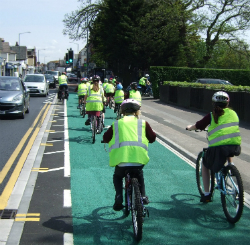I can tell it’s a nice area because it’s the kind of place where you can see children cycling to school in the morning.
This was the recent remark of a friend who had moved to the south coast of England. This friend is not a cyclist but I think it says a lot about the associations that cycling has with prosperity, health and the liveability of cities – all of which are concerns of the Future of Cities project.
'Active travel in the city of the future', Phil Insall’s contribution to the Future of Cities project is both valuable and timely. Our current modes of urban mobility are demonstrably unsustainable, causing us physical, mental and economic harm. Congestion is estimated to cost the economy £11 billion a year1; air pollution is estimated to be a factor in 28,000 premature deaths a year2; commuting by car is worse for wellbeing and mental health than by any other mode of transport3 and the increasing prevalence of non-communicable diseases such as obesity and diabetes are leading to rising costs of health and social care. When the social costs are factored together, estimates hold that these impacts cost the UK up to £40 billion a year4.
Changing travel behaviour

(Garry Knight/CC BY-SA 2.0)
While individual lifestyles and choices are important determinants of urban mobility and travel behavior, there are 2 important points which should be borne in mind when thinking about the future of active travel:
Firstly, that these individual decisions are strongly shaped by the context in which they are made. As such, the increasing weight and unhealthiness of people should be seen as the result of a normal response by normal people to an abnormal environment. Our built environment and urban transport system are an abnormal environment where people make mobility choices which damage their health and that of others.
Secondly, the future doesn’t just happen - it has to be created (either by action or inaction). We are not necessarily set on this course, we should be able to take action to alter this abnormal environment. However, Phil identifies that in the case of active travel the conditions to take actions are not in place.
Too many benefits?

Perhaps ironically, the problem is that active travel has too many benefits. The bulk of policy and investment would come from transport, whereas the benefits would really be felt in the health, social care and environment sectors. This is particularly true at the urban scale, where the health savings from locally sourced transport investment would flow back in to the national balance sheets of the NHS.
There are both cross-scale and cross-sectoral dimensions constraining our policy choice and therefore our ability to change our abnormal built environment.
Vision for the future
Both our built environment and urban transport system should be a matter of genuine choice. If we can overcome current barriers and realise our ability to positively shape active travel, the benefits will be many:
- reduced congestion on our roads
- a healthier, happier and more productive population
- reduced air pollution
- reduced demands on public spending
- the creation of an attractive and desirable environment for private investment
Let us know your thoughts in the comments below.
Featured image by Alexander Baxevanis on Flickr. Used under Creative Commons.
Sign up for email alerts from this blog, or follow us on Twitter.


4 comments
Comment by Emma posted on
What about scooters...
Comment by georgie posted on
This is not rocket science, common sense means we've known how great active travel is for decades and yet repeatedly its been ignored and terribly underfunded. Following the recommendations of the All Party Cycling Inquiry is a start so please do not let this report just be more empty gestures and tick boxes. Real continued investment is needed. But more than that, making active travel the more attractive option is the only way to benefit people's health and ease congestion.
Comment by Kate Mcguire posted on
I think that we are actually moving forward. With a slow pace but people are starting to realise the consequences. Not that we'll stop using our cars and polluting the environment and our minds but some of us are at least trying. I see more and more people who use the bike-sharing system or the DLR. George is right though, there is a need to make active travel the preferred option other wise we're heading down a dark road.
Comment by William posted on
I have just returned from travelling Central America where places such as Panama have just built a metro system. Its only 2 years old and offer journeys costing just 35cents. That same journey would cost a good few pounds here in the UK. Now Panama is a very developed country so think its fair to comapre to England, but cant but help think that there is a financial incentive for people to use a more energy efficient form of transport. On returning to my hometown of Nottingham and phase 2 of the Tram network has finished providing a fantastic artery of quiet, fast, efficient and most of all 'green' travels to ferry people around our busy city. Phase 1 showed a massive uptake of tram use. Now there is a huge decrease in vehicle traffic on the roads and polution levels have come down too...my question is why dont more cities build trams into theri infrastructure? Your article raises some great thoughts and in searching for the answers to this question, stumbled across this blog post....